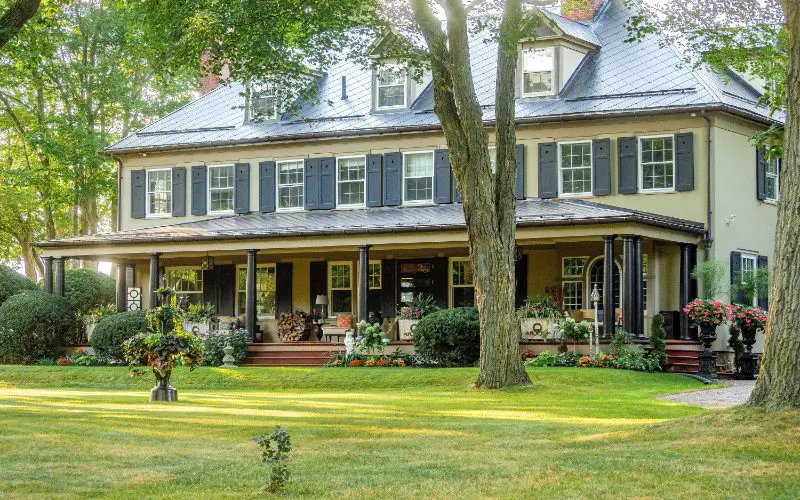
Sold: Homewood, The Perfect House
188 Dorset St W, Port Hope, Ontario, Canada
Homewood is a house I have a real connection with, having been a weekend guest on numerous occasions in the distant past and can honestly tell you – this place is just magical! Not that I don’t go to a lot of weekend events at friends’ homes and cottages (hey, I’m a popular guy!) -the difference here is the home itself. This captivating place in Port Hope was like stepping back in time – stepping back visually of course while not giving up any of the luxuries which are now considered necessities for a comfortable, civilized weekend (let’s be honest, I like atmosphere, but I’m not a hillbilly!). It was this house that showed me places like these actually do exist in reality (not just in novels or on television), and could be very easily lived in. Those weekends were an enchanting, eye-opening experience. That is what continues to intrigue me about this house – at 6,315 square feet (plus basement) it is a relatively large home (by today’s standards), yet it maintains a sense of intimacy, with lower ceilings, warm comforting woodwork, and well-proportioned rooms – none of the pomp and circumstance of today’s McMansions with their double height impersonal rooms, redundant spaces, overdone ornamentation and impersonal, magazine perfect decorating.
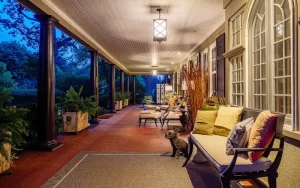 For context, Port Hope is a charming, historical lakefront town about an hour east of Toronto along the north shores of Lake Ontario. The town, and neighbouring Coburg, became a known ‘established’ location for wealthy Americans in the late 1800’s, namely those of the upper classes who had the means to construct summer estates in the area. These families were drawn to the area by the relative closeness of the location to their American homes and of the casual lifestyle Port Hope offered as a break from the structured lives demanded by their established urban peers.
For context, Port Hope is a charming, historical lakefront town about an hour east of Toronto along the north shores of Lake Ontario. The town, and neighbouring Coburg, became a known ‘established’ location for wealthy Americans in the late 1800’s, namely those of the upper classes who had the means to construct summer estates in the area. These families were drawn to the area by the relative closeness of the location to their American homes and of the casual lifestyle Port Hope offered as a break from the structured lives demanded by their established urban peers.
The grand, yet surprisingly informal home was constructed in 1899 by wealthy Pittsburgh native James Ernest Schwartz (1843 – 1900) in 1899. Unfortunately, James Schwartz died at Hotel Bellevue in Dresden, Germany on May 16, 1900, a mere few months following the completion of his Port Hope Summer house. Ironically, he was travelling in Germany at the time on the advice of his physician who had prescribed the German climate as a combative measure for his failing health. Schwartz left behind his wife of 30 years, Emma Nicholson and their two sons who sold the property in 1904 to Montrealer Julia Greenshields. In the decades which followed, there were a series of owners who shepherd the home through changing economic circumstances and lifestyle requirements. Over time, the costs and challenges of running a large and aging house became apparent and, as with many similar homes of the era, the house slowly deteriorated into a state of disrepair. Fortunately, in 1977, Toronto based Dr. Ronald McDonald (yea … not that one) and his wife Anne purchased the house and restored her to her former glory before selling the house to Darrell Kent and his partner Peter Brown in 1983, who operated the house as the informal weekend place it was meant to be.
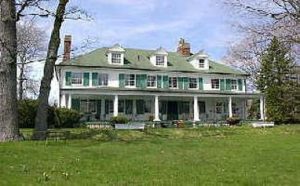
This was Homewood as it appeared during my visits
Darrell Kent owned the home until his death in 1989, with Peter Brown continuing to weekend at the home until he sold in 2001. It was in the later parts of the Peter Brown tenureship that a younger and more impressionable me began to be invited to weekend events.
I mentioned in the title of this entry that this was the “perfect house” and I still believe that, at the time, it was. As opposed to the multi roomed mega palaces, people of means gravitate to today, Homewood has a mere 5 rooms on the main floor, contains no double height ceilings (which, lets be honest, most people have no idea how to make a two-story room feel comfortable and inviting), and exudes comfortable casual living. Running the entire length of the street facing façade of the home is a relaxing 63-foot-long front veranda perfectly designed for the accommodation of scattered groupings of wicker furniture, slow revolving ceiling fans, and the unstructured enjoyment of long lazy summer days. I know from experience that this is a perfect space for sipping mint julips while watching a good game of croquet or badminton on the front lawn, rather than an entrance designed for formal black-tie dinners or coming out balls. 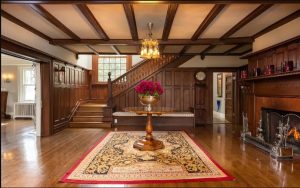 Entering the house through a four-foot-wide craftsman style solid oak door, one finds himself in the large square entrance hall facing the main staircase. At just shy of 500 square feet, this space is larger than an average 2 car garage and, like the balance of the home, boasts plenty of warm oak: floors, ceiling beams, mantles, paneling – all of which echo the craftsman detailing introduced by the home’s entrance door. A large welcoming fireplace (one of 7 in the home) with the home’s christened name: “Homewood” carved in script in its oak mantle sets the tone for the rest of the home. This room was always centered by a round table topped with a crazy, large fresh floral display during my visits.
Entering the house through a four-foot-wide craftsman style solid oak door, one finds himself in the large square entrance hall facing the main staircase. At just shy of 500 square feet, this space is larger than an average 2 car garage and, like the balance of the home, boasts plenty of warm oak: floors, ceiling beams, mantles, paneling – all of which echo the craftsman detailing introduced by the home’s entrance door. A large welcoming fireplace (one of 7 in the home) with the home’s christened name: “Homewood” carved in script in its oak mantle sets the tone for the rest of the home. This room was always centered by a round table topped with a crazy, large fresh floral display during my visits.
The balance of the main floor contains a generously proportioned fireplaced living room concealed behind oak double pocket doors, a formal dining room which featured a table which easily sat 24 during my visiting years and housed another great hearth and a swinging door into the butler’s pantry, which I will swoon over later. A final door off the foyer closes off the back area of the home originally reserved for staff. Beyond this door, a hall passes a discrete powder room, a delicious back staircase running from the home’s basement up through to its third floor, the back entrance and the home’s kitchen. The kitchen was in its original turn of the century configuration when I first saw the home – a uniquely functional space with an enormous original white porcelain sink, assorted free standing prep spaces and a large harvest table in the center of the room. At first taken back by the lack of storage in the large room, I was educated by the host that this was a space reserved for the preparation of meals, storage was provided next door in the butler’s pantry.
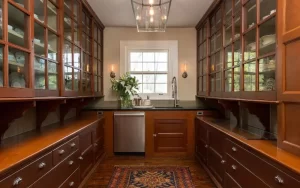 Ah, the butler’s pantry – a room that absolutely mesmerizes me with its beautiful millwork and functionality. A room frozen in another time, dedicated to the storage and cleaning of dishes, not the preparation of food. I would purchase this house for this room alone! This functional space contains beautifully crafted floor to ceiling, glass doored shelving, velvet lined drawers (to protect the silverware), wash sinks and plenty of counter space. I remember the large assortment of plates, antique serving dishes and utensils one could play with while setting out elaborate group dinners – the owners actually enjoying these dishes for everyday entertainment. I remember these upper cupboards being stock full of an endless assortment of sets of stemware – each size and shape designated for your beverage of choice (red, white, brandy, cognac, etc.) and whose numbers would be one or two shy each evening following the regular enjoyment of adult beverages by that weekend’s guests.
Ah, the butler’s pantry – a room that absolutely mesmerizes me with its beautiful millwork and functionality. A room frozen in another time, dedicated to the storage and cleaning of dishes, not the preparation of food. I would purchase this house for this room alone! This functional space contains beautifully crafted floor to ceiling, glass doored shelving, velvet lined drawers (to protect the silverware), wash sinks and plenty of counter space. I remember the large assortment of plates, antique serving dishes and utensils one could play with while setting out elaborate group dinners – the owners actually enjoying these dishes for everyday entertainment. I remember these upper cupboards being stock full of an endless assortment of sets of stemware – each size and shape designated for your beverage of choice (red, white, brandy, cognac, etc.) and whose numbers would be one or two shy each evening following the regular enjoyment of adult beverages by that weekend’s guests.
The second floor contains the main / family bedrooms, each warmed by its own fireplace, (bedroom fireplaces along with a proper pantry, have become essential items on my list of “must haves” on my real estate quest). 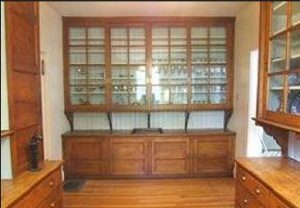 The balance of the floor contains an original, highly crafted oak “linen room” and a couple of bathrooms – one, a uniquely out of place, but still charming, original art deco bathroom, whose pedigree was the source of endless speculation for its novel charm when touring the home. Tragically, this delightful room has been McMansionized by the current owners who instead desired an over decorated, generic marble box rather than this tiled and chrome masterpiece.
The balance of the floor contains an original, highly crafted oak “linen room” and a couple of bathrooms – one, a uniquely out of place, but still charming, original art deco bathroom, whose pedigree was the source of endless speculation for its novel charm when touring the home. Tragically, this delightful room has been McMansionized by the current owners who instead desired an over decorated, generic marble box rather than this tiled and chrome masterpiece.
The third floor in its day, I believe would have been reserved for staff, and accessed only by the back staircase, contains two bedrooms (one with yet another fireplace), a simple bathroom and a large sleeping dormitory which during my visits was used for parties (as was most of the house for that matter)
During the Kent/Browne era, the couple had the basement excavated to incorporate a 2-car garage, created a small greenhouse by enclosing the original stone access stairwell in glass, and added an indoor spa equipped with a whirlpool, shower, and sauna.
Unfortunately, like the “modernization” of the Art Deco bathroom, much of the homes’ retained original charm (service-oriented kitchen, main bathrooms, etc.) did not fit with today’s requirements for luxury and as shown in recent listing photos, have been replaced by the current owners with homogenized, catalogue versions of the same rooms (which incorporate weird-ass glass kitchen shelving units in front of the room’s windows). If nothing else, we can thank the Kitchen Gods they at least spared the butler’s pantry!
In June 2005, the house was listed for $910k, selling in July for $905k, then, reflecting changing circumstances in the Port Hope market, the house was listed again in Dec, 2008 for a desperate $799k, selling 3 months later for the drastically reduced $695k at which time the present owners scooped up the home. This owner modernized the rooms discussed, which in hindsight did pay off for them as they were able to capitalize on the COVID crazed surge in real estate. They listed the now “McMansionized” home on Apr 14, 2022 for a whopping $3.999 mill, selling one month later for $3.9mill. So, I guess their bastardized update of the home paid off… Hey, what do I know.
More pictures of Homewood can be found here